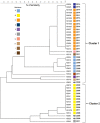Genetic Diversity of Plasmodium falciparum Populations in Malaria Declining Areas of Sabah, East Malaysia
- PMID: 27023787
- PMCID: PMC4811561
- DOI: 10.1371/journal.pone.0152415
Genetic Diversity of Plasmodium falciparum Populations in Malaria Declining Areas of Sabah, East Malaysia
Abstract
Malaysia has a national goal to eliminate malaria by 2020. Understanding the genetic diversity of malaria parasites in residual transmission foci can provide invaluable information which may inform the intervention strategies used to reach elimination targets. This study was conducted to determine the genetic diversity level of P. falciparum isolates in malaria residual foci areas of Sabah. Malaria active case detection was conducted in Kalabakan and Kota Marudu. All individuals in the study sites were screened for malaria infection by rapid diagnostic test. Blood from P. falciparum-infected individuals were collected on filter paper prior to DNA extraction. Genotyping was performed using merozoite surface protein-1 (MSP-1), merozoite surface protein-2 (MSP-2), glutamate rich protein (GLURP) and 10 neutral microsatellite loci markers. The size of alleles, multiplicity of infection (MOI), mean number of alleles (Na), expected heterozygosity (He), linkage disequilibrium (LD) and genetic differentiation (FST) were determined. In Kalabakan, the MSP-1 and MSP-2 alleles were predominantly K1 and FC27 family types, respectively. The GLURP genotype VI (751-800 bp) was predominant. The MOI for MSP-1 and MSP-2 were 1.65 and 1.20, respectively. The Na per microsatellite locus was 1.70. The He values for MSP-1, MSP-2, GLURP and neutral microsatellites were 0.17, 0.37, 0.70 and 0.33, respectively. In Kota Marudu, the MSP-1 and MSP-2 alleles were predominantly MAD20 and 3D7 family types, respectively. The GLURP genotype IV (651-700 bp) was predominant. The MOI for both MSP-1 and MSP-2 was 1.05. The Na per microsatellite locus was 3.60. The He values for MSP-1, MSP-2, GLURP and neutral microsatellites were 0.24, 0.25, 0.69 and 0.30, respectively. A significant LD was observed in Kalabakan (0.495, p<0.01) and Kota Marudu P. falciparum populations (0.601, p<0.01). High genetic differentiation between Kalabakan and Kota Marudu P. falciparum populations was observed (FST = 0.532). The genetic data from the present study highlighted the limited diversity and contrasting genetic pattern of P. falciparum populations in the malaria declining areas of Sabah.
Conflict of interest statement
Figures



Similar articles
-
Extensive diversity in the allelic frequency of Plasmodium falciparum merozoite surface proteins and glutamate-rich protein in rural and urban settings of southwestern Nigeria.Malar J. 2018 Jan 2;17(1):1. doi: 10.1186/s12936-017-2149-5. Malar J. 2018. PMID: 29291736 Free PMC article.
-
Plasmodium falciparum genetic diversity and multiplicity of infection based on msp-1, msp-2, glurp and microsatellite genetic markers in sub-Saharan Africa: a systematic review and meta-analysis.Malar J. 2024 Apr 8;23(1):97. doi: 10.1186/s12936-024-04925-y. Malar J. 2024. PMID: 38589874 Free PMC article.
-
Genetic diversity of Plasmodium falciparum isolates from Pahang, Malaysia based on MSP-1 and MSP-2 genes.Parasit Vectors. 2011 Dec 13;4:233. doi: 10.1186/1756-3305-4-233. Parasit Vectors. 2011. PMID: 22166488 Free PMC article.
-
Genomic miscellany and allelic frequencies of Plasmodium falciparum msp-1, msp-2 and glurp in parasite isolates.PLoS One. 2022 Mar 8;17(3):e0264654. doi: 10.1371/journal.pone.0264654. eCollection 2022. PLoS One. 2022. PMID: 35259187 Free PMC article.
-
Genetic diversity in Plasmodium falciparum merozoite surface protein 1 and 2 coding genes and its implications in malaria epidemiology: a review of published studies from 1997-2007.J Vector Borne Dis. 2009 Mar;46(1):1-12. J Vector Borne Dis. 2009. PMID: 19326702 Review.
Cited by
-
Genetic Diversity of Merozoite Surface Protein-1 and -2 Genes in Plasmodium falciparum Isolates among Asymptomatic Population in Boset and Badewacho Districts, Southern Ethiopia.J Parasitol Res. 2022 Dec 14;2022:7728975. doi: 10.1155/2022/7728975. eCollection 2022. J Parasitol Res. 2022. PMID: 36569519 Free PMC article.
-
Temporal changes in genetic diversity of msp-1, msp-2, and msp-3 in Plasmodium falciparum isolates from Grande Comore Island after introduction of ACT.Malar J. 2018 Feb 20;17(1):83. doi: 10.1186/s12936-018-2227-3. Malar J. 2018. PMID: 29458365 Free PMC article.
-
Genetic diversity of Plasmodium falciparum isolates from uncomplicated malaria cases in Ghana over a decade.Parasit Vectors. 2016 Jul 26;9(1):416. doi: 10.1186/s13071-016-1692-1. Parasit Vectors. 2016. PMID: 27460474 Free PMC article.
-
Severe oxidative stress in sickle cell disease patients with uncomplicated Plasmodium falciparum malaria in Kampala, Uganda.BMC Infect Dis. 2019 Jul 9;19(1):600. doi: 10.1186/s12879-019-4221-y. BMC Infect Dis. 2019. PMID: 31288760 Free PMC article.
-
Bias-corrected maximum-likelihood estimation of multiplicity of infection and lineage frequencies.PLoS One. 2021 Dec 29;16(12):e0261889. doi: 10.1371/journal.pone.0261889. eCollection 2021. PLoS One. 2021. PMID: 34965279 Free PMC article.
References
-
- WHO. World Malaria Report. 2015.
-
- Anderson TJ, Haubold B, Williams JT, Estrada-Franco JG, Richardson L, Mollinedo R, et al. Microsatellite markers reveal a spectrum of population structures in the malaria parasite Plasmodium falciparum. Mol Biol Evol. 2000;17(10):1467–82. . - PubMed
Publication types
MeSH terms
Substances
LinkOut - more resources
Full Text Sources
Other Literature Sources
Research Materials
Miscellaneous

